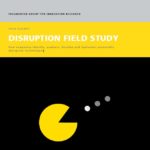How does a beautiful car differ from a fast one? Is there an objective way to compare two different characterizations? The question about how companies distinguish between radical innovations and disruptive technologies is discussed by Sven Schimpf of Fraunhofer.
Radical innovations are those that provide a significant increase in performance compared to reference solutions – at least from the microeconomic perspective. A potentially disruptive technology is one that displaces an established technology with a major impact on the industry. For example the mp3 codec, a key component of streaming services, shook up the traditional players in the music industry and created a new way to consume music.
Within the Fraunhofer disruption field study, companies were asked about how they manage potentially disruptive technologies at different stages from identification, through development to implementation, in comparison to other technologies.
Findings of the study
Unstructured – management of potentially disruptive technologies was found to be rather unstructured and rarely based on formalised processes. The degree of management was related to the time available for the CEO to take an interest in the technology.
Inward looking – companies frequently used identical search spaces for potentially disruptive technology and sustaining technologies, although, in the past, most disruptions had their origin in fields outside the core business of the companies concerned.
Intuition not objectivity – the most commonly cited method for evaluating potentially disruptive technologies is employee intuition, potentially missing the insights that could be provided by external experts.
Existing structures are used for management – disruptive technology is by its nature disruptive and frequently unpopular with employees; using the existing structures could reduce adoption of new ideas.
The conclusion
Although disruptive technology is widely discussed, the findings of the Fraunhofer field study suggests that there is a considerable opportunity to improve how the technologies are sourced and implemented. The field study provides some insights on how to do that. I look forward to further discussion of the topic and hope you enjoy reading!
The study is freely available here: http://s.fhg.de/disruptionfieldstudy


